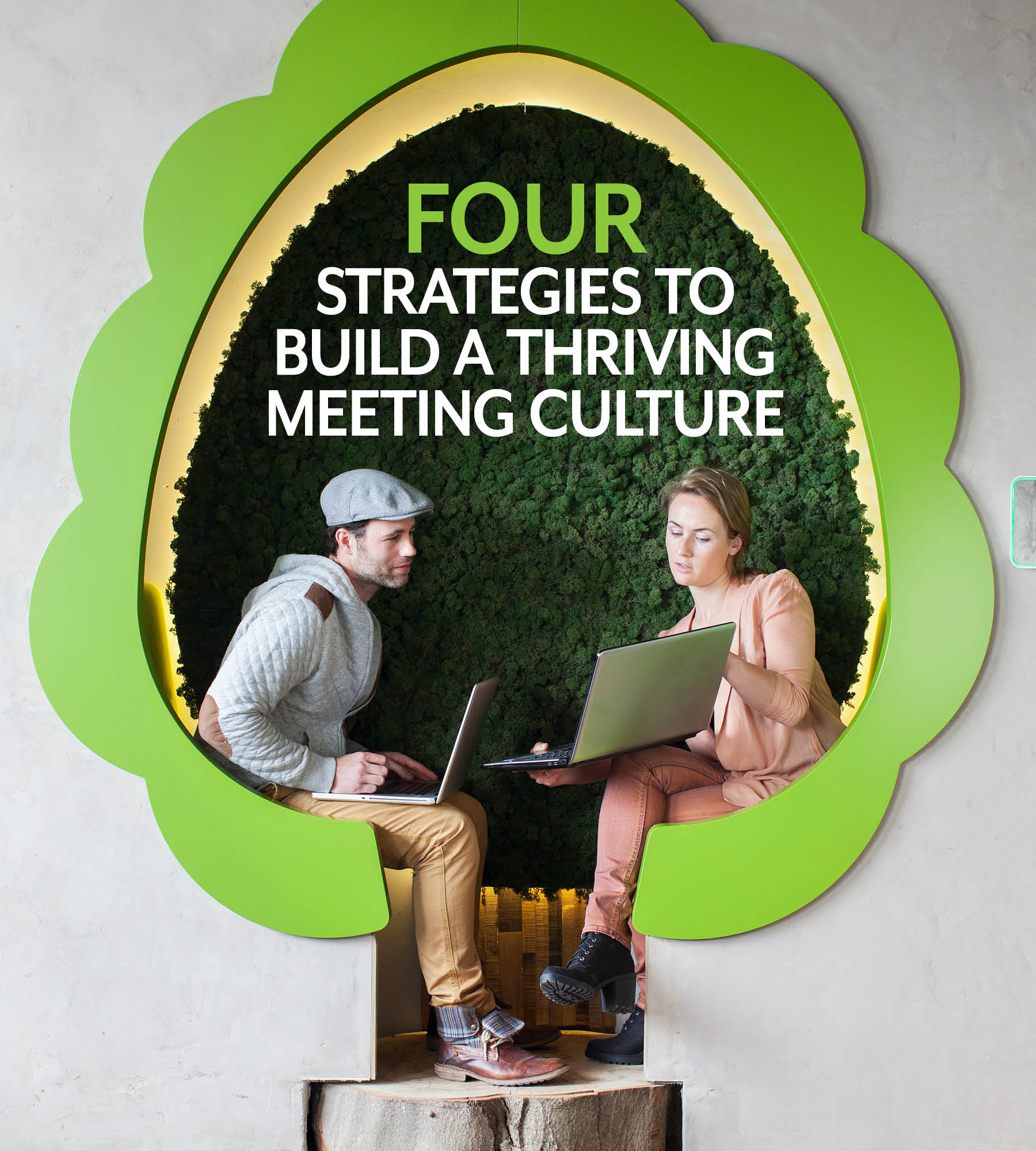Language
You can read the magazine in one of the following languages
Geolocation
You can read the global content or the content from your region

The number one obstacle to productivity in the workplace is inefficient meetings. The third productivity disruptor is too many meetings, according to Microsoft’s ‘Work Trend Index’.
This shouldn’t come as a surprise. Due to the status quo meeting culture, we all regularly experience too many inefficient meetings. However, the solution is not to merely have fewer meetings. Instead, what if executives focus on how to optimize meetings for the best outcomes?
Executives have the opportunity to build a thriving meeting culture by focusing on how meetings could be more productive, energizing, engaging and motivating.
Consider a status quo meeting. What comes to mind? Status quo meetings typically include a dense PowerPoint with an overload of information. When there is discussion, the same few people respond each time, potentially dominating the conversation. At the end of the meeting, next steps are quickly confirmed. Most participants haven’t spoken throughout the meeting.
One major issue with the status quo meeting culture is leaders are in back-to-back meetings the entire day, shifting gears constantly, without any space for thinking, planning, actually getting work done or being human.

Executives have the opportunity to build a thriving meeting culture by focusing on how meetings could be more productive, energizing, engaging and motivating.
On top of that, the majority of meetings are disorganized and unproductive, lacking a meeting agenda or purpose, without a structure and actionable takeaways.
Why ineffective meetings are problematic:
When companies create a thriving meeting culture, it sets the tone for better work products, improves team cohesion and increases energy throughout the system. Intentional and well-structured meetings can be highly effective both when entirely virtual and in-person; though a hybrid format is not as effective unless utilizing optimal technology.
Benefits of a thriving meeting culture include:
Through my research, I uncovered Vital Leadership is key to creating a thriving workplace. Leading with Vital Leadership creates the highest leadership capacity, improves team performance, and helps organizations thrive.
Vital Leadership places leading yourself first, by cultivating your wellbeing as foundational to maximizing leadership performance. When leaders promote their own wellbeing, it builds their vitality, giving them access to an abundance of energy. There are four components important for how leaders care for their energy every day: physical, psychological, emotional and spiritual.
Applying the four factors of Vital Leadership to meetings provides the framework to foster a thriving meeting culture.

Cultivating physical vitality in meetings begins with recognizing we are human beings with physical bodies, not robots. We are not meant to sit all day without opportunities to move, eat or drink, which is draining. By incorporating movement and opportunities to refuel our bodies during or between meetings, it will boost our energy throughout the day.
Strategies include:
Reflection: What meeting practices might support everyone’s physical wellbeing?
When companies create a thriving meeting culture, it sets the tone for better work products, improves team cohesion and increases energy throughout the system.

To encourage psychological vitality, provide a clear meeting purpose and agenda, involve attendees in intellectually stimulating discussions, and update meeting practices to include space between meetings and no-meeting times. This results in leaders having increased mental stamina.
Strategies include:
Reflection: What meeting practices could be intellectually stimulating?

Fostering emotional vitality involves intentionally including opportunities to connect, cultivate positive emotions and build relationships. It creates a wonderful gateway toward increased connection and openness during meetings.
Strategies include:
Reflection: How could everyone connect to each other and cultivate positivity throughout the meeting?
The Four Factors of Vital Leadership provide leaders a framework to operate at their highest leadership capacity where they spend the majority of their time – in meetings.

To promote spiritual vitality means connecting the meeting to the bigger picture and creating an environment where everyone has the opportunity to show up at their best. It is essential to cultivating a deeper sense of fulfillment in work, of which meetings are a core aspect.
Strategies include:
Reflection: How could everyone connect to their best selves and/or something greater than themselves during the meeting?
Executives can overcome the depleting nature of the status-quo meeting culture by creating a thriving meeting culture. The Four Factors of Vital Leadership provide leaders a framework to operate at their highest leadership capacity where they spend the majority of their time – in meetings. It builds an environment where everyone is consistently energized, engaged and motivated while tackling problems and business challenges.
By creating conditions for human thriving during meetings, leaders have the opportunity to maximize leader, team and organization performance and productivity.

Jamie Shapiro
Contributor Collective Member
Jamie Shapiro is a master-certified executive leadership coach and organizational psychologist who specializes in working with CEOs of public companies and their executive teams. She is the CEO and Founder of Connected EC, a C-suite executive coaching company, and the author of ‘Brilliant: Be the Leader Who Shines Brightly Without Burning Out’. For more information about Connected EC, visit https://www.connectedec.com/